During the course of
the Zhou Dynasty as compared with the case studies about Rome and early Europe,
it was shown how feudal states in China were more autonomous, had no
overlapping, cross-cutting authorities, and had strong territorial markers. And
that during the course of the Zhou Dynasty we see a shift from transbordersovereignty to absolute sovereignty with the
Warring States Period representing a
transitional phase to imperial China. From the age of Confucius onward, the
Chinese people in general and their political thinkers, in particular, began to
think about political matters in terms of the world.
Then when the Eastern
Han government gave up its attempts to restrict the rise of a dependent
tenantry, and in so doing abandoned direct administration of the countryside in part two we thus have seen how steppe chieftains
were given economic subsidies in return for longterm
military service to help protect the Chinese boundaries from other steppe
nations.
In the west
threatening the Roman empire, on the other hand, we will next see how the Huns
quickly expanded their territory with lightning-fast cavalry and accurate
archers, inspiring fear wherever they went.
In addition to their military might, the Huns were skilled at forging
alliances with local tribal leaders by exchanging goods for loyalty.
The Chinese Empire
recognized that war was an expensive prospect, and it was, therefore, better to
avoid large-scale conflict. Thus, to maintain peace on the frontiers, the later
Han regime paid massive subsidies to foreign nations to buy their workforce for
military service or to deter attacks. By the first century AD, the Chinese were
paying 101 million cash per year to the Southern Xiongnu
on the Han frontiers and 270 million to the Xianbei
on the Mongolian Steppe. Similar payments were made to the border-based Wuhuan nation and the Western Qiang on the southern borders
of China (Tibet-Burma).1 Amounts worth 740 million cash were equivalent to
about 148 million sesterces in Roman currency. This sum would have paid the
salaries of a large standing army, the equivalent of thirteen legions, except
that the Han considered it safer and more economical to purchase peace.
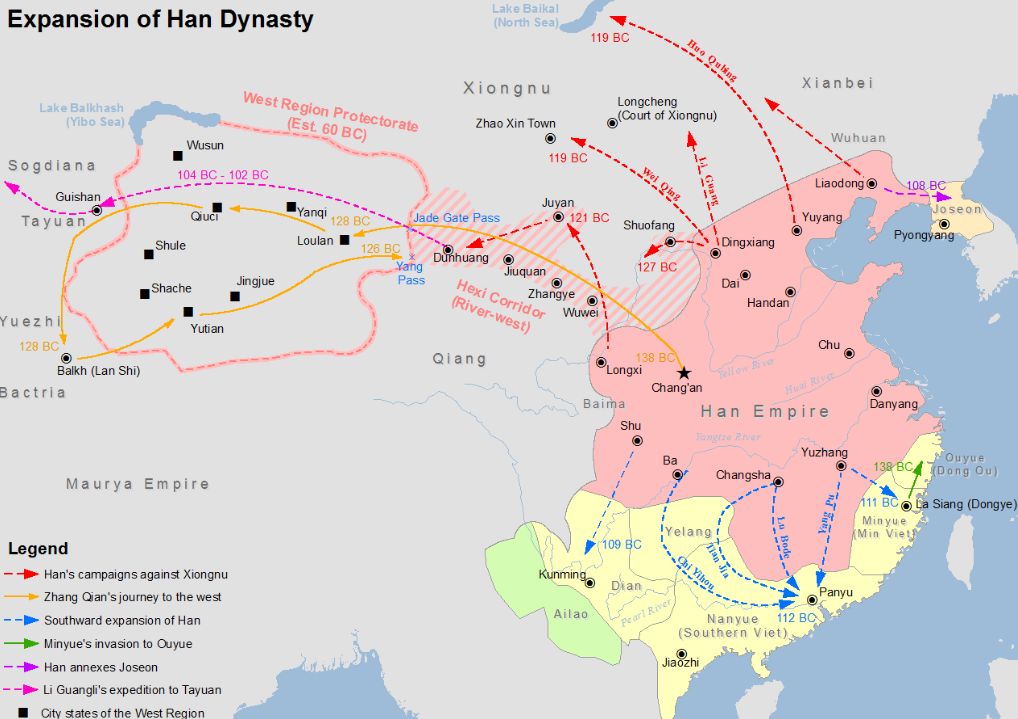
The early Chinese and
Roman Empires each faced different military, political, and financial
challenges. Both regimes had to raise substantial revenues to finance state
administration and create a military infrastructure that could prevent internal
unrest and deter foreign invasion. The Romans met these demands by spending
large sums on a vast professional army while the Chinese maintained a smaller
military structure and made tribute payments to external powers to ensure peace
and stability on their frontiers. Silk produced in Chinese workshops had a unique international value, and this gave the
Han a valuable renewable resource, other than precious metal, to pay border
troops and bribe foreign regimes.
The Chinese
established a large and expensive bureaucracy that could manage the high levels
of tax revenue extracted from its subjects. By contrast the early Roman Empire
generated much of its required income from mining precious metal bullion and
taxing the international commerce that developed between its territories and
the eastern world. Commercial taxes financed the Roman regime, but the bullion
that their merchants spent at trade centers in Babylonia, Arabia, and India was
a finite resource. Trade imbalances ensured that the Roman Empire could not
sustain its original prosperity or adapt to the challenges of late
antiquity.
Crucially, the Roman
military failed to master steppe warfare, and consequently, the appearance in
Europe of a steppe nation from East Asia was to cause the collapse of their
empire.
Xiongnu, Huns and the End of Empire
In the fourth century
AD, an offshoot of the Xiongnu (Hun-nu) nation moved west onto the Pontic-Caspian Steppe. The Xiongnu (Chinese: 匈奴; Wade–Giles: Hsiung-nu) were a tribal confederation
of nomadic peoples who inhabited the eastern Eurasian Steppe from the 3rd
century BC to the late 1st century AD.
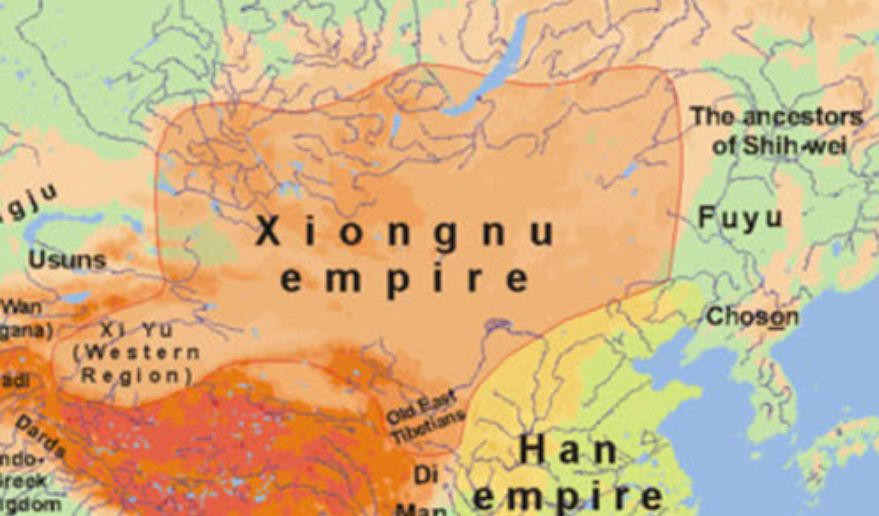
These Xiongnu nomadic pastoral people who at the end of the 3rd
century BCE formed a great tribal league that was able to dominate much of
Central Asia for more than 500 years. China’s wars against the Xiongnu, who were a constant threat to the country’s
northern frontier throughout this period, led to the Chinese exploration and
conquest of much of Central Asia.
It is these Xiongnu that is known to the Romans as the Huns who
defeated the Alani and conquered the populous Gothic realms in Eastern Europe.
In the process, they caused a significant refugee movement into Europe, which
destabilized the Roman Empire. Over the following century, the Huns launched
devastating attacks on Roman territory that destroyed frontier defenses and
eventually caused the downfall of the Western Roman Empire (AD 476).
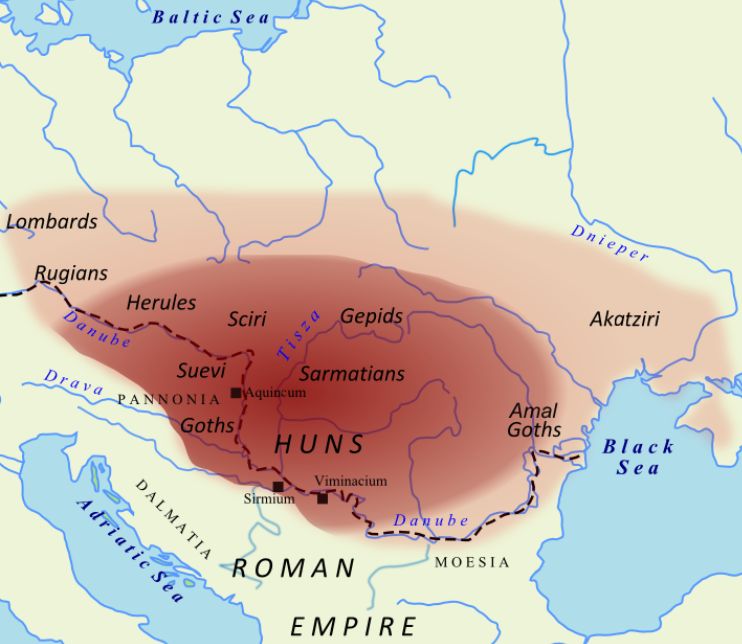
This westward
movement of Xiongnu people occurred in a period of
Chinese history known as the Sixteen Kingdom Era (AD 304–439). The Sogdian
Letters record how the resurgent Xiongnu (Hun)
overran northern China in AD 312 and
sacked the walled capital Luoyang.2 The attack was led by a southern Xiongnu faction who called themselves the ‘Han Zhao’
because their leaders claimed to be descendants of the Han dynasty princess
that Chanyu Modu had received as his royal bride.
With an army of 50,000 steppe warriors, the Han Zhao also sacked the former
capital Chang’an, capturing two Jin Emperors during
the course of their campaigns (AD 304–319).3
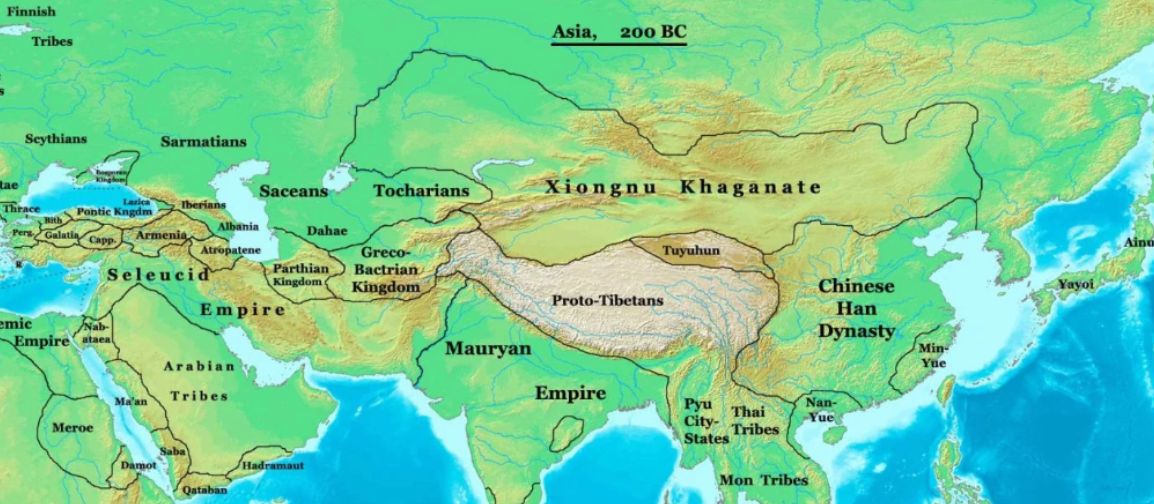
As a consequence, the
northern domains of China fractured into numerous small kingdoms formed from
various nations and dynasties that had once been Chinese subjects. Some of
these states and their successors existed in steppe territories ruled by
warlords descended from the Southern Xiongnu. This
included the Northern Lang in the Hexi Corridor, the Northern Tiefu of Inner Mongolia, and the Kingdom of Xia in the
Ordos Loop. Between AD 351 and AD 376, a robust frontier regime known as Former
Qin began to conquer its warring rivals, but it was the Northern Wei that
achieved overall victory and established control over northern China (AD
386–534).
The Northern Wei
governed with Chinese-style administration and promoted their regime using
Buddhist ideologies. But their ruling dynasty was descended from Xianbei warlords, so the system possessed numerous skilled
cavalry that could campaign on the steppe. Their rise to power prompted a
migration of Xiongnu
factions westward towards the Caspian steppe. A Chinese text called the Weishu (History of
the Northern Wei) records that by the start of the fourth century ‘the remains of the Xiongnu
descendants’ were to be found northwest of the steppe-dwelling Rouran who by
that period occupied most of Central Asia.4

One of these Xiongnu groups called themselves the ‘White’ clan which was
the symbolic color of the West in their ancient culture.5 The Roman historian
Ammianus confirms that this subgroup followed a migration route into
Transoxiana where they threatened lands subject to the Sassanid Persian Empire
(AD 356).6
The Persians called
these invaders ‘Chionites’, but the Indians referred
to them as ‘Huna’.7 The Chionites quickly overran Bactria, and the Byzantine
scholar Faustus records how in AD 368 the Persian King recruited Armenian
troops into his armies to try to defend his eastern provinces.8 Writing in the
sixth century the Byzantine scholar Procopius calls these invaders ‘the
Hephthalite Huns, who are called White
Huns’ and reports that ‘they do not intermix with any of the other Huns known
to us.’9 He claims that the Huns did not
seem to be ‘Scythians’ and had no ‘regal government’. 10 Claudian confirms that
the Huns came from somewhere beyond the ‘extreme eastern borders of Scythia’.11
Ammianus explains: ‘A hitherto unknown race of men has arisen from some hidden
recess of the earth and like a tempest of snows from the high mountains they
seize or destroy everything in their way.’12

Another subgroup of Xiongnu (Huns) first appears in Roman accounts in AD 370
when they arrived in lands to the north of the Caspian Sea and crossed the
Volga River. Coming from unknown territories, these Huns rapidly conquered the
Alani and Goths, who occupied steppe lands north of the Black Sea (Scythia).
Zosimus reports that ‘a barbarous nation, which had remained unknown until this
time, suddenly made its appearance and attacked the Scythians beyond the Ister (Danube).’
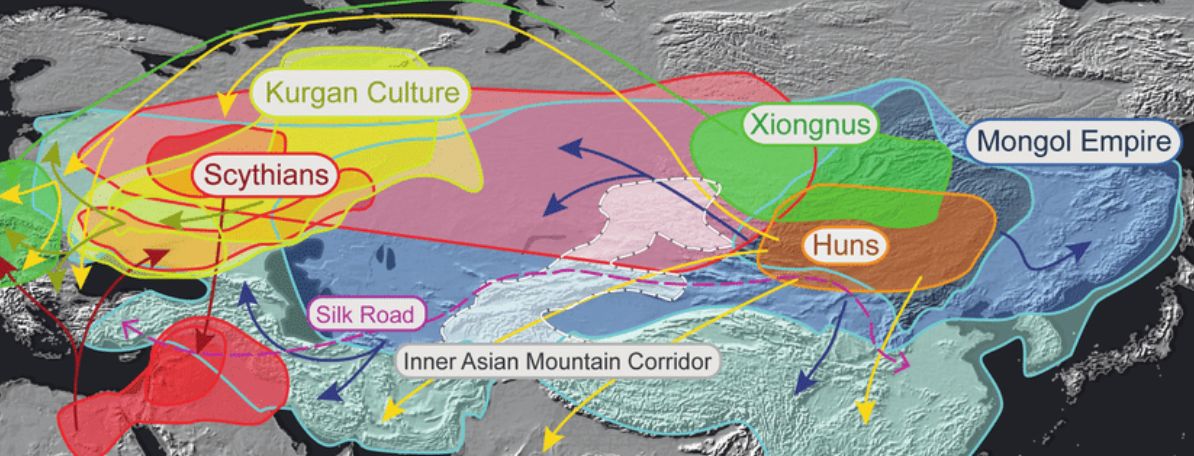
The Huns had migrated
to seek land, and they arrived on the Pontic steppe with their wives, children,
horses, and wagons.13 Zosimus explains that their warriors ‘were not capable of fighting on foot, rarely
walked, could not fix their feet firmly on the ground, but live perpetually,
and can even sleep, on horseback’.14 According to Roman accounts they possessed superior
horses, more considerable skill at archery, and demonstrated more persistence
in their attacks than other steppe nations.
Jordanes, the
sixth-century Byzantine historian, describes them as being ‘tanned with a large
head that is not distinct. Their eyes are small, resembling a pinhead.’ He
reports that male Huns ritually scarred their faces with blades as displays of
mourning enacted at funeral services.15 Procopius also suggests that the Huns
had a distinctive haircut that was copied by the riotous gangs who watched
chariot races in Constantinople. The Hun haircut was achieved by ‘clipping the
hair short on the front of the head down to the temples, then letting it hang
down in great length and disorder at the back’.16
Jordanes reports that
the Huns were ‘short in stature with fast physical movements, alert horsemen,
broad-shouldered and primed in the use of bow and arrow, with firm-set necks held erect with
pride’.17Ammianus offers a similar account, describing the Huns as possessing
‘compact bodies, strong limbs, and thick necks.’
He suggests they were
disfigured by a lifetime of horse-riding and walked awkwardly when they
dismounted.18 Sidonius compared the Huns to the centaurs of classical
mythology, describing how they learned to ride as soon as they could walk.
He reports, ‘You
would think that the limbs of man and horse are fused so firmly does the rider
always move with the horse; other people are carried on horseback, but these
people live there.’19 Ammianus reports that even their war councils were
conducted while mounted and ‘when deliberation is required regarding important
matters, they all consult as a common body on horseback.’20
Hunnic horses were
considered superior to the western breeds used by Scythians on the Pontic
Steppe and Roman cavalry in Europe. A Roman named Vegetius wrote a study on
veterinary medicine in which he lists the characteristics of these horses. They
had ‘large hooked heads, protruding eyes, narrow nostrils, broad jaws, strong and stiff necks, manes hanging
below their knees, overlarge ribs, curved backs, bushy tails, great strength in
their cannon bones, small pasterns,
wide-spreading hooves, hollow loins, angular rumps without fat or
muscles, a back stature that is long
rather than high, drawn in belly and large bones.’ This accurately describes
the horses used by Central Asian steppe nations.
Roman horses were
expensive to maintain since they had to be kept warm in stables and required
frequent veterinary attention. Vegetius explained that Hunnic horses did not
need barns and could endure more significant cold and hunger without distress.
They were also longer-lived and less prone to injury than their Roman
counterparts. Hunnic breeds were also better able to bear wounds due to their
quiet and sensible temperament. Therefore in the opinion of Vegetius, they held ‘first place among horse breeds in their
fitness for war’.21

Skilled Hun bowmen
could outpace and outmaneuver armored Sarmatian riders who specialized in
cavalry charges carrying cumbersome lances. Jordanes reports that the Alani
‘equaled the Huns in battle but had different cultures, manners, and
appearance. The Huns exhausted them by their incessant attacks and subdued
them.’22 Zosimus confirms that their warriors overcame the western steppe
dwellers with continual attacks and ‘by the rapidity with which they wheeled
about their horses, by the suddenness of their excursions and retreats,
shooting as they rode they caused a great slaughter among the
Scythians.’23Claudian refers to their attacks which seemed ‘disorderly, but had
incredible swiftness, allowing the Huns to often return to the fight when
little expected’.24
Ammianus describes
how Hunnic warriors rode into battle in wedge-shaped masses, while ‘their
medley of voices makes a savage noise.’ They were ‘lightly equipped for swift
motion and unexpected action, they purposely divide suddenly into scattered
bands and attack, rushing about in disorder here and there, dealing terrific
slaughter.’ The Huns surpassed all other warriors in the skill of their
archery, but when the opportunity came, ‘they can gallop over the intervening
ground and fight hand-to-hand with swords.’ They also lassoed their enemies
throwing ‘strips of cord plaited into nooses over their opponents, entangling
and binding their limbs so they cannot ride or walk.’25 Unlike the Chinese who
possessed sophisticated crossbows, the Goths and Romans had no projectile
weaponry that could easily outrange and target mounted Hunnic archers.
Ammianus records that
within a few years the Huns ‘had overrun the territories of the Alani,’ they
‘killed and plundered many of them, then joined the survivors to themselves in
a treaty of alliance.’26 This gave Hunnic armies the Sarmatian cavalry equipped
with scale and chain mail armor. After suppressing the Alani, the Huns moved
west to attack the Goths, who by the fourth century AD were a populous nation
inhabiting agricultural territories stretching from the Baltic coast to the
northern Black Sea. The Goths on the Pontic steppe had adopted cavalry
practices, but they fought with spears instead of the sophisticated reflex bows
used by the Scythians. Procopius explains that Gothic bowmen ‘entered battle on
foot under cover of heavily armed men’.27
Gothic spearmen could
not ride faster than Hunnic warriors, and even in close combat, Goth riders
could find it challenging to overcome Huns equipped with helmets and lamellar
armor. Procopius describes how an elite Hun soldier ‘was surrounded by twelve Goths
carrying spears whom all struck at him at once, but his corselet withstood the blows, and he was not
seriously injured until one of the Goths
succeeded in hitting him from behind, in a place where his body was
unprotected, above the right armpit’. This Hun was only wearing a helmet and
jacket-like coat of chain or lamellar armor since another spear-thrust wounded
his exposed thigh.28
Roman sources suggest
that it was challenging to unseat or kill a mounted Hunnic warrior. Sidonius
describes a Hun who was speared by a lance, ‘transfixed, his corselet was
pierced front and back so that blood came throbbing through the two holes.’29
Some Huns carried shields, and Sozomen describes a
Hunnic warrior leaning on his shield, ‘as was his custom when parleying with
his enemies’.30
Grave finds suggest
that some Huns practiced the steppe custom of artificial cranial deformation
and by binding the heads of their babies they encouraged the infant’s skull to
develop in an elongated shape.31 Some Romans assumed that this practice was connected
with warfare, to flatten the face and make it easier for warriors to wear
helmets with broad nose-guards.32 A few wealthy Huns gilded their armor,
perhaps emulating the customs of the Aorsi who wore
gold ornaments.33 Asterius of Amasia reports that ‘the armor of the barbarians
is ostentatious’ and describes a steppe chief on the Black Sea coast who
offered his gilded cuirass to a Christian representative.34

When the Huns
defeated the Gothic kingdoms, tens of thousands of refugee Goths and Alani fled
south to seek protection in the Roman Empire. Ammianus reports that ‘exhausted
by a lack of necessities they looked for a new homeland far from the savages
and after much deliberation, they chose Thrace as a suitable refuge, because it
has very fertile soil and because it is separated by the mighty flood of the Danube from the lands
exposed to war.’ The Gothic realms were allied to the Roman Empire, and
Ammianus records how a large part of the defeated nation suddenly appeared on
the banks of the Danube asking admittance into imperial territory.35 Zosimus
reports, ‘The surviving Scythians (Goths and
Alani) were compelled to abandon their homelands to the Huns and cross
the Danube, they, therefore, appealed to
the Emperor to receive them, promising to
serve faithfully as soldiers.’ Tens of thousands of Goths and Alani were
admitted into the frontier provinces along with their families, but despite
confiscation orders, many were able to bribe officials and cross the Danube
carrying weapons.36
These refugees were
confined to camps near the frontier, but they were offered limited supplies
while they were systematically exploited and mistreated by various Roman
officials. As a result, the Gothic refugees rebelled and overran the Balkan
countryside with raiding parties (AD 376–378). In AD 378 the Eastern
Emperor Valens marched against the
Gothic army, but their steppe cavalry outmaneuvered him at the Battle of
Adrianople.37 The Emperor was killed along with most of the Eastern Field Army
while their enemies ‘plundered the dead bodies and armed themselves with Roman
equipment’.38
The Goths dominated
imperial politics throughout the following century as their various
nation-states crossed the Empire to seize territories from imperial
control. They overran rich agricultural
territories, demanded tribute from Roman cities, and captured various armories
and imperial workshops. The Visigothic chief Aleric
boasted that the Roman province of Thrace forged spears, swords, and helmets
for his warriors.39 Meanwhile, the Huns moved westwards towards the grasslands
of Hungary on the Danube frontier. In a few decades, they had conquered and
occupied a territory stretching over 1,700 miles from the Roman Danube to the
Volga River.
The Threat to Rome
Theodosius I was the
last Emperor to rule a unified Roman regime. In AD 393, he placed his
9-year-old son on the throne of the Western Empire under the guidance and
protection of a senior general named Flavius Stilicho. Theodosius was then
succeeded by his eldest son Arcadius who ruled the Eastern Empire from a
bureaucratic court, while the western government fell under the authority of
generals assisted by Gothic and Germanic warlords brought into regular imperial
service.
Authorities in the
Western Roman Empire sought alliances with the Huns, who occupied large parts
of Eastern Europe and the Pontic-Caspian steppe. By contrast, the Eastern Roman
Empire was a target for Hunnic raids, aggression, and extortion. In AD 395, the
Huns sent an army through passes in the Caucasus Mountains to raid the Eastern
Roman Empire. Jerome describes the sudden terror of these attacks as
‘everywhere their approach was unexpected as their speed overtook any rumor of
their coming and they spared neither religion, rank nor age.’ Hunnic armies
entered Armenia and rode south to plunder Syria, as the population of Antioch
and Tyre retreated into their cities. Roman
authorities suspected that the Huns might be planning to rob gold from
Jerusalem and wealthy citizens fled onto ships to avoid capture or death.40
Jerome confirms the impact of these raids when he writes that ‘the soldiers of
Rome who are conquerors and lords of the world are subdued, tremble and
withdraw in fear at the sight of those who cannot easily walk on foot.’41
The Huns then turned
their attention west and subjugated populations in central Germany, prompting a
further movement of displaced Germanic peoples into the Western Roman Empire.
In AD 405 tens of thousands of Suebians, Vandals, and
Alani crossed the Rhine frontiers along with their families to settle in Roman
Gaul. Up to 80,000 Vandals migrated through Spain and in AD 429 they crossed
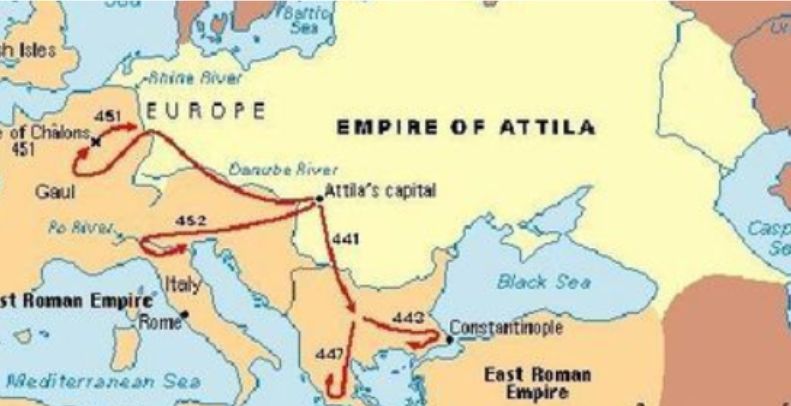
Antioch and Tyre retreated into their cities. Roman authorities
suspected that the Huns might be
planning to plunder gold from Jerusalem and wealthy citizens fled onto ships to
avoid capture or death.42Jerome confirms the impact of these raids when he
writes that ‘the soldiers of Rome who are conquerors and lords of the world are
subdued, tremble and withdraw in fear at the sight of those who cannot easily
walk on foot.’43
The Huns then turned
their attention west and subjugated populations in central Germany, prompting a
further movement of displaced Germanic peoples into the Western Roman Empire.
In AD 405, tens of thousands of Suebians, Vandals,
and Alani crossed the Rhine frontiers along with their families to settle in
Roman Gaul. Up to 80,000 Vandals migrated through Spain and in AD 429 they
crossed into North Africa to seize the fertile farmlands that supplied grain to
Rome.44
During this period,
military leaders in the Western Roman Empire recruited Hunnic warriors into
imperial service as the elite bodyguards of senior commanders. The Western Emperor Honorius (AD 393–423)
maintained 300 Huns in the Italian capital Ravenna and Stilicho, the Magister Militum (‘Master of Soldiers’), was protected by a personal
bodyguard of Hunnic troops.45 In AD 409, the Emperor summoned a mounted force,
including 10,000 Hunnic allies, to help defend Italy from an army of Visigoths
who were threatening Rome. Zosimus suggests that the Romans found it difficult
to feed and supply this number of horse riders and the riders withdrew allowing
the Visigoths to sack Rome the following year.46 In AD 425, a Roman commander named Flavius Aetius
requested the support of a Hunnic army to decide a succession dispute in the
Western Roman Empire. He led 60,000 allied Hunnic warriors into Northern Italy
before negotiating a peace that allowed him to claim the title Magister
Militum.47 By this period Hunnic armies incorporated the most influential
military traditions of their subject peoples, and Jordanes describes their
varied appearance including ‘Suebi (Germans) fighting on foot, Huns with bows
and the Alani forming-up into a heavy-armed battle-line’.48
In AD 445, a chief
named Attila was proclaimed king of the Huns and, after unifying his subject
peoples, ‘he gathered a host of the other tribes under his power.’ Jordanes
describes Attila as ‘short of stature, with a broad chest and a large head; his
eyes were small, his beard thin and greying, and he had a flat nose and tanned
complexion.’ He was said to be ‘enthusiastic for war, but restrained in
action, mighty in counsel, gracious to
suppliants and lenient to those who were received into his protection’.49
Under the command of
Attila, Hunnic armies reduced the political and military strength of the Roman
regime and caused the collapse of the Western Empire. Like the Xiongnu, the Huns wanted to dominate and extract wealth
from their imperial rivals, rather than conquer or destroy them. It was said
that when Attila captured the Italian city of Milan, he saw a painting of the
Roman Emperors sitting upon golden thrones and Scythians lying dead before
their feet. He ordered the image redrawn to depict ‘Attila upon a throne and
the Roman Emperors heaving sacks upon their shoulders and pouring out gold
before him’.50 Attila’s funeral oration was reported to have praised him as the
chief who ‘held the Scythian and German realms, terrified both Roman Empires,
captured their cities and placated by their appeals, took yearly tribute in
place of plunder’.51
Attila’s attacks on the
Eastern Roman Empire began in AD 441 when Hunnic armies crossed the Danube
frontier and plundered the Balkans. The Huns had with them Roman captives with
the engineering skills required to bridge rivers. They also brought numerous
battering-ram siege engines that they mounted on large steppe-wagons. If
threatened by attack, these massive timber wagons could be quickly drawn into
formation to create a fortress-like wooden stronghold. Priscus describes the
siege of a fortified Roman city called Naissus when
the Huns drove ‘a vast number of siege engines’ against the walls. Archers
fired from wicker and hide-protected portholes in these wagons, forcing the
defenders from the battlements, as the battering-rams were rolled forward.
These rams consisted of a sizeable metal-headed beam fixed to chains so that it
could be drawn back with ropes, then swung forward with pendulum force. The
walls of Naissus were battered down at numerous
points, allowing the Huns and their Gothic allies to scale the rubble with ladders
and plunder the city.52 These sieges were rapid operations conducted with
overwhelming force, and in AD 443, the Huns threatened but did not attack, the heavily-fortified imperial capital of
Constantinople (Byzantium). Tens of thousands of Roman subjects, including many
skilled urban tradespeople, were seized in their raids and conveyed to the
Hunnic homelands in Hungary and the Pontic steppe. A Roman chronicle describes
the conflict as ‘a new disaster for the east:
more than seventy cities were sacked while no assistance came from the
troops of the Western Empire’.53

The Eastern Empire
bought peace terms with the Huns for 6,000 pounds of gold and an agreement that
a further 2,100 pounds of gold per annum would be given as tribute (equivalent
to 8.4 million sesterces of first-century currency).54 In addition, thousands
of Roman prisoners were returned at a ransom of 8 gold solidi per person.55
According to Priscus, ‘these tributes were very heavy, as many resources and
the imperial treasuries had been exhausted.’56 Priscus reports: ‘The Romans
pretended that they had made the agreements voluntarily. But because of the
overwhelming fear which gripped their commanders, they were compelled to accept
gladly every injunction, however harsh, in their eagerness for peace.’57
Despite these protests, the Eastern Empire could pay further tribute, and John
Lydus reports that in AD 457 the treasury preserved 100,000 pounds of
gold, ‘which Attila, the enemy of the
world, had wanted to take’.58
In AD 449, Priscus
was selected by the government of the Eastern Roman Empire to lead an embassy
to the court of Attila. He traveled to one of the Hunnic capitals north of the
Danube, which resembled a vast wood-built village the size of a Roman town. Attila’s
royal residence was constructed from close-fitting polished timbers and
ornamental wooden boards and, although it had a perimeter adorned with towers,
the complex was built ‘for beauty rather than protection.’ Priscus reports that
a Roman captive taken from the city of Sirmium had
made a heated bath-house at the site, confirming the new engineering skills
then available to the regime. Attila received envoys and petitions and oversaw
legal cases in his royal hall. Priscus records that one of his royal
secretaries was a Roman administrator named Rusticius
who was another war-captive, employed by the Huns because of ‘his skills in
speech and composing letters’.59 Attila was also promoting his regime using
motifs from the Sarmatian religion and claimed to have discovered the sacred
sword of the classical war god Mars (Ares).60
Another incident
indicates the Hunnic capacity for acculturation. Priscus met a former Roman
merchant in the Hunnic capital who spoke fluent Greek but was dressed in full
‘Scythian attire’ and cut his hair in their distinctive style. The Greeks
explained he had been a wealthy inhabitant of Viminacium
near the Danube River, but when the city was stormed, he was captured and
brought into Hunnic service.
He had ‘fought
bravely in battles against the Romans’ and with the spoils ‘he had obtained his
freedom according to the law of the Scythians.’ He could have returned to the
Empire, but he married a Scythian woman, had children by his foreign wife and
continued to serve the Huns.61
While Priscus was
attending the Hunnic court, he spoke to visiting envoys from the Western Roman
government about the threat posed by Attila. They explained to Priscus that ‘no
one who ruled over Scythia or any other land had achieved such great things in
such a short time.’ They warned that Attila ‘rules all of Scythia, makes the
Romans pay tribute and is aiming at more significant achievements for he wants
to engage the Persians and enlarge his territories’. The envoys explained that
Media was no great distance from the Hunnic regions, and the Huns knew the main
routes through the Caucasus Mountains. They believed that Attila, ‘with little
difficulty and only a short journey, would subdue the Medes, Parthians, and
Persians and force them to submit to the payment of tribute. For he has a
military force which no nation can resist.’ One of the envoys from Rome named Constantiolus warned that if Persia fell to the Huns, then
Attila would dictate ruling terms on the Western Roman Empire. Constantiolus claimed, ‘At present, we bring Attila gold
for the sake of his rank, but if he overwhelms the Parthians, Medes, and
Persians, he will no longer endure the rule of independent Romans.’62 But
contrary to Roman expectations the Huns
did not engage the Persian Empire as their next military target. In AD 450, Attila received a pretext for war
against the Western Roman Empire.
Honoria, the
disgraced half-sister of the Emperor Valentinian III, sent a marriage proposal
to Attila. This union would have given Attila controlling interests in the
imperial succession, but the marriage was refused by the Roman court, who
insisted that Honoria marry an aging senator. At the same time, the Eastern
Roman Empire withheld the annual gold tribute that it had agreed to pay to the
Huns.
Priscus reports that
‘Attila was undecided whom he should attack first, but resolved to begin with
the greater war and advance against the West since his fight there would be
against Goths and Franks’ who had fled Hunnic rule for Roman protection.63
In AD 451, Attila
attacked the Western Roman Empire with a Hunnic army supported by large numbers
of subject Goths (Ostrogoths) and Germans. His invasion force would have
included more than 60,000 warriors, making it the largest field-army operating
in the western world. Attila plundered cities in Gaul and ‘launched a fierce assault with his
battering-rams’ on the heavily fortified town of Orleans.64 In response, the Western Roman
regime allied with the Alani, Franks,
and Visigoths who occupied large parts of Gaul and viewed the Huns as their
traditional enemies. The two armies fought a large-scale engagement at the
Battle of the Catalaunian Plains that ended with a
stalemate and the withdrawal of the Hunnic army from Gaul.65
The following year
the Hunnic army crossed the Alps and sacked the significant cities in northern
Italy before threatening Rome itself (AD 452). On this occasion, the Roman
regime could not obtain support from their Germanic allies, and the remaining
imperial units were unable to manage an adequate defense. Jordanes describes
how the Hunnic army attacked the fortified city of Aquileia: ‘Bringing forward
all manner of war-engines, they quickly forced their way into the city,
plundered it, divided the spoils and so cruelly devastated the place that
scarcely anything remained.’ He claims that the invaders ‘devastated the most
significant part of Italy’ before approaching Rome.66 Pope Leo was chosen as
the envoy to Rome, and the western government was forced to agree on peace
terms that made their empire tributary to the Huns. Attila also reasserted his
claim to an imperial marriage alliance and demanded the government surrender
the princess Honoria, ‘with her due share of the royal wealth’.67
The campaign had
exhausted the Roman capacity for war, and the regime was open to invasion and
exploitation by further foreign powers. With the Western Empire subdued, Attila
returned with his army to his Hungarian realm to plan new campaigns against the
Visigoths and Alani.68 He was also anticipating conflict with the Eastern Roman
Empire as it was withholding the promised tribute payments to the Hunnic court.
But in AD 453, on the night of his marriage to a German princess named Ildico, Attila suddenly died from a brain hemorrhage .69
The fate of Honoria is not known, and she may have remained in Rome under
imperial custody. The death of Attila caused subject nations to rebel and his
empire disintegrated in a series of conflicts. The Hunnic threat diminished,
but by this period, large parts of the Western Roman Empire were under the
direct rule of Germanic nations who had conquered relevant territories or been
given land in return for military service. The last ever Emperor of Rome was a
boy named Romulus Augustus, who was deposed by a Germanic king named Odoacer in
AD 476. It had taken less than a century for a significant steppe incursion
with an influx of foreign refugees to destabilize, undermine, and destroy the
Roman Empire.
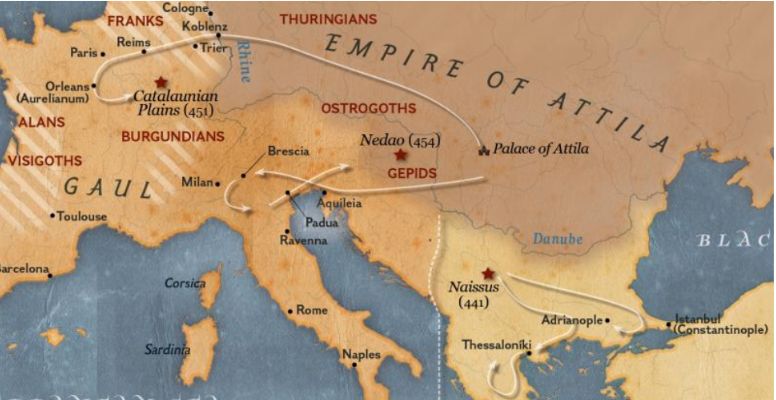
In antiquity, the
Huns were the largest and most significant population group to have traveled
across the steppe from the Far East to the Roman frontiers, a journey of more
than 5,000 miles. But during the long history of the silk routes, many other
unnamed, impoverished, or dispossessed individuals passed through the empires
of Central Asia as the consequence of conflict, slavery, or commerce.
Archaeologists excavating the ancient site of an imperial estate at Vagnari in southern Italy unearthed the graves of slave
workers who had been involved in textile production during the first century
AD. DNA testing of skeletal remains revealed that one of the men buried in the
plot had Far Eastern ancestry inherited from his mother.70
In spite of all the
wealth associated with the silk routes, his sole possession was a plain wooden
food bowl, placed next to his body for use in the afterlife. Whomever this man
was and however his ancestors had found themselves in the very center of the
Roman Empire, he had ended his days as a slave and was buried in a simple grave
on a bleak hillside.
Yet while the Chinese
empire recovered from its numerous fragmentations and invasions and remained a
unified nation. The explanations why the Roman Empire did not recover from its
fall. As we have seen, in the middle of the
second century, the Romans controlled a huge, geographically diverse part of
the globe, from northern Britain to the edges of the Sahara, from the Atlantic
to Mesopotamia. The generally prosperous population peaked at 75 million. Eventually,
all free inhabitants of the empire came to enjoy the rights of Roman
citizenship.
Five centuries later,
the Roman empire was a small Byzantine rump-state controlled from
Constantinople, its near-eastern provinces lost to Islamic invasions, its
western lands covered by a patchwork of Germanic kingdoms. Trade receded,
cities shrank, and technological advance halted. Despite the cultural vitality
and spiritual legacy of these centuries, this period was marked by a declining
population, political fragmentation, and lower levels of material complexity.
This violent sequence
of eruptions triggered what is now called the “Late
Antique Little Ice Age” when much colder temperatures endured for at least
150 years. This phase of climate deterioration had decisive effects in Rome’s
unraveling.

(A to D) Evolution of
central European forest cover and population from (A), together with oak sample
replication (B), their historical end dates at decadal resolution (C), and
examples of archaeological (left), subfossil, historical, and recent (right) sample
sources (D).
Claims that the
decisive factor in Rome’s biological history was the arrival of new germs the
Antonine plague the Plague of Cyprian and in the sixth century, the bubonic
plague, have
recently been contested.
Footnotes upon request you can write to me at
ericvandenbroeck1959@gmail.com
For updates click homepage here